中国政治制度的研究共36页
- 格式:ppt
- 大小:4.91 MB
- 文档页数:36
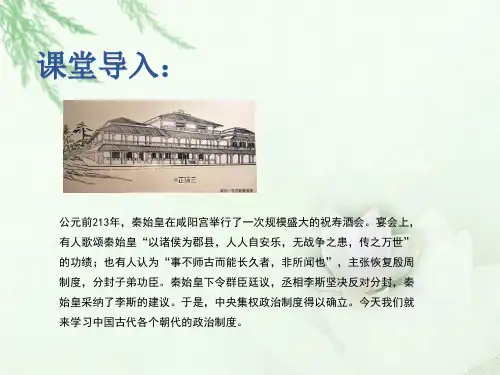
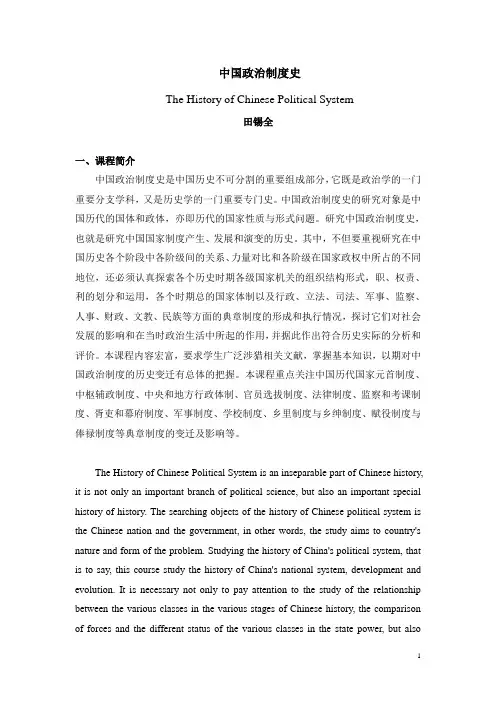
中国政治制度史The History of Chinese Political System田锡全一、课程简介中国政治制度史是中国历史不可分割的重要组成部分,它既是政治学的一门重要分支学科,又是历史学的一门重要专门史。
中国政治制度史的研究对象是中国历代的国体和政体,亦即历代的国家性质与形式问题。
研究中国政治制度史,也就是研究中国国家制度产生、发展和演变的历史。
其中,不但要重视研究在中国历史各个阶段中各阶级间的关系、力量对比和各阶级在国家政权中所占的不同地位,还必须认真探索各个历史时期各级国家机关的组织结构形式,职、权责、利的划分和运用,各个时期总的国家体制以及行政、立法、司法、军事、监察、人事、财政、文教、民族等方面的典章制度的形成和执行情况,探讨它们对社会发展的影响和在当时政治生活中所起的作用,并据此作出符合历史实际的分析和评价。
本课程内容宏富,要求学生广泛涉猎相关文献,掌握基本知识,以期对中国政治制度的历史变迁有总体的把握。
本课程重点关注中国历代国家元首制度、中枢辅政制度、中央和地方行政体制、官员选拔制度、法律制度、监察和考课制度、胥吏和幕府制度、军事制度、学校制度、乡里制度与乡绅制度、赋役制度与俸禄制度等典章制度的变迁及影响等。
The History of Chinese Political System is an inseparable part of Chinese history, it is not only an important branch of political science, but also an important special history of history. The searching objects of the history of Chinese political system is the Chinese nation and the government, in other words, the study aims to country's nature and form of the problem. Studying the history of China's political system, that is to say, this course study the history of China's national system, development and evolution. It is necessary not only to pay attention to the study of the relationship between the various classes in the various stages of Chinese history, the comparison of forces and the different status of the various classes in the state power, but alsoseriously explore the various historical periods at all levels of state organs of the organizational structure, the formation and implementation of the rules and regulations of the various national systems and administrative, legislative, judicial, military, supervisory, personnel, finance, culture and education, ethnic groups and other aspects of the formation and implementation of the system. This course systematically explores their social development and the role played in the political life at that time, and makes in line with the historical analysis and evaluation. The content of this course is abundant, so, it guides students to extensively cover the relevant literature, master the basic knowledge with a view to the historical changes in China's political system have overall grasp.This course focuses on the system of leader-selection of China, the central government system, the central and local administrative system, the officials’ selection system, the legal system, the supervi sion and examination system, the military system, the school system, Gentry system, tax system and the salary system and so on. It requires students to read relevant literature extensively, master the basic knowledge and grasp the historical changes in China's political system.二、教学目标在方法上,每讲都梳理各个历史阶段的制度变迁总体态势及其时代特色,中间穿插权威观点、补充背景内容,课后提供讨论和探究活动的建议和进一步阅读的文献。
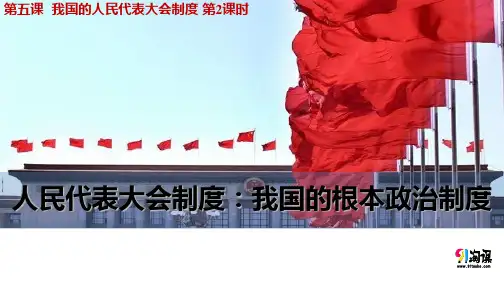
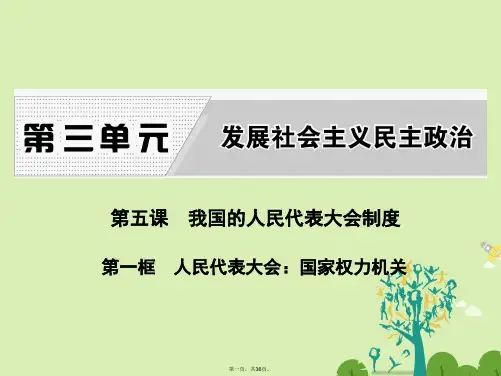
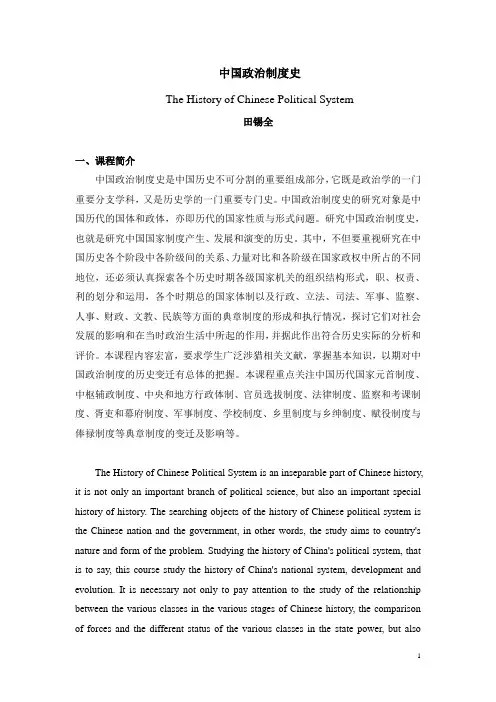
中国政治制度史The History of Chinese Political System田锡全一、课程简介中国政治制度史是中国历史不可分割的重要组成部分,它既是政治学的一门重要分支学科,又是历史学的一门重要专门史。
中国政治制度史的研究对象是中国历代的国体和政体,亦即历代的国家性质与形式问题。
研究中国政治制度史,也就是研究中国国家制度产生、发展和演变的历史。
其中,不但要重视研究在中国历史各个阶段中各阶级间的关系、力量对比和各阶级在国家政权中所占的不同地位,还必须认真探索各个历史时期各级国家机关的组织结构形式,职、权责、利的划分和运用,各个时期总的国家体制以及行政、立法、司法、军事、监察、人事、财政、文教、民族等方面的典章制度的形成和执行情况,探讨它们对社会发展的影响和在当时政治生活中所起的作用,并据此作出符合历史实际的分析和评价。
本课程内容宏富,要求学生广泛涉猎相关文献,掌握基本知识,以期对中国政治制度的历史变迁有总体的把握。
本课程重点关注中国历代国家元首制度、中枢辅政制度、中央和地方行政体制、官员选拔制度、法律制度、监察和考课制度、胥吏和幕府制度、军事制度、学校制度、乡里制度与乡绅制度、赋役制度与俸禄制度等典章制度的变迁及影响等。
The History of Chinese Political System is an inseparable part of Chinese history, it is not only an important branch of political science, but also an important special history of history. The searching objects of the history of Chinese political system is the Chinese nation and the government, in other words, the study aims to country's nature and form of the problem. Studying the history of China's political system, that is to say, this course study the history of China's national system, development and evolution. It is necessary not only to pay attention to the study of the relationship between the various classes in the various stages of Chinese history, the comparison of forces and the different status of the various classes in the state power, but alsoseriously explore the various historical periods at all levels of state organs of the organizational structure, the formation and implementation of the rules and regulations of the various national systems and administrative, legislative, judicial, military, supervisory, personnel, finance, culture and education, ethnic groups and other aspects of the formation and implementation of the system. This course systematically explores their social development and the role played in the political life at that time, and makes in line with the historical analysis and evaluation. The content of this course is abundant, so, it guides students to extensively cover the relevant literature, master the basic knowledge with a view to the historical changes in China's political system have overall grasp.This course focuses on the system of leader-selection of China, the central government system, the central and local administrative system, the officials’ selection system, the legal system, the supervi sion and examination system, the military system, the school system, Gentry system, tax system and the salary system and so on. It requires students to read relevant literature extensively, master the basic knowledge and grasp the historical changes in China's political system.二、教学目标在方法上,每讲都梳理各个历史阶段的制度变迁总体态势及其时代特色,中间穿插权威观点、补充背景内容,课后提供讨论和探究活动的建议和进一步阅读的文献。
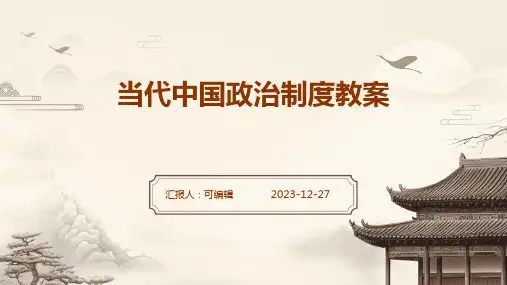
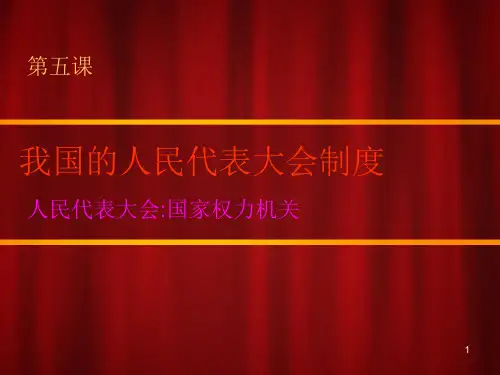
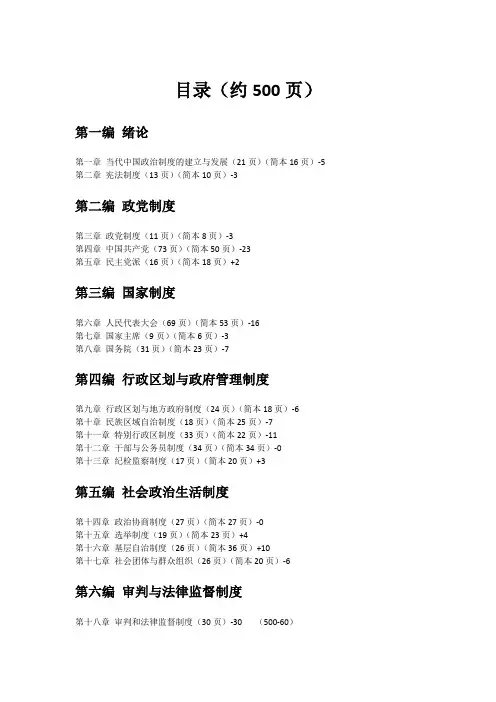
目录(约500页)第一编绪论
第一章当代中国政治制度的建立与发展(21页)(简本16页)-5 第二章宪法制度(13页)(简本10页)-3
第二编政党制度
第三章政党制度(11页)(简本8页)-3
第四章中国共产党(73页)(简本50页)-23
第五章民主党派(16页)(简本18页)+2
第三编国家制度
第六章人民代表大会(69页)(简本53页)-16
第七章国家主席(9页)(简本6页)-3
第八章国务院(31页)(简本23页)-7
第四编行政区划与政府管理制度
第九章行政区划与地方政府制度(24页)(简本18页)-6
第十章民族区域自治制度(18页)(简本25页)-7
第十一章特别行政区制度(33页)(简本22页)-11
第十二章干部与公务员制度(34页)(简本34页)-0
第十三章纪检监察制度(17页)(简本20页)+3
第五编社会政治生活制度
第十四章政治协商制度(27页)(简本27页)-0
第十五章选举制度(19页)(简本23页)+4
第十六章基层自治制度(26页)(简本36页)+10
第十七章社会团体与群众组织(26页)(简本20页)-6
第六编审判与法律监督制度
第十八章审判和法律监督制度(30页)-30 (500-60)。
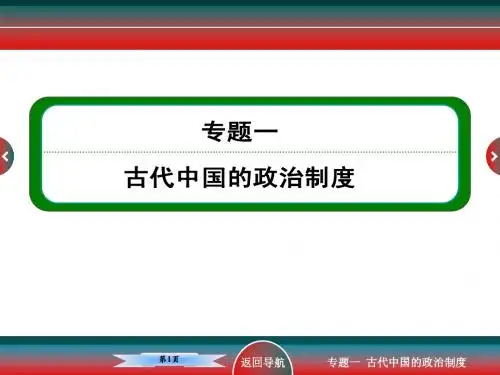
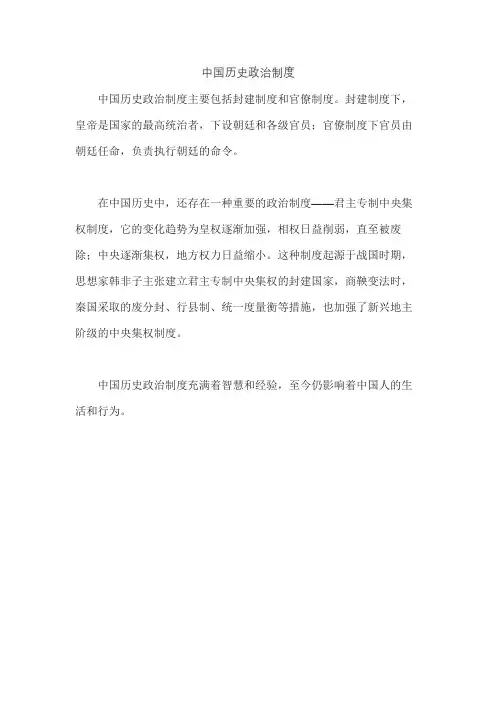
中国历史政治制度
中国历史政治制度主要包括封建制度和官僚制度。
封建制度下,皇帝是国家的最高统治者,下设朝廷和各级官员;官僚制度下官员由朝廷任命,负责执行朝廷的命令。
在中国历史中,还存在一种重要的政治制度——君主专制中央集权制度,它的变化趋势为皇权逐渐加强,相权日益削弱,直至被废除;中央逐渐集权,地方权力日益缩小。
这种制度起源于战国时期,思想家韩非子主张建立君主专制中央集权的封建国家,商鞅变法时,秦国采取的废分封、行县制、统一度量衡等措施,也加强了新兴地主阶级的中央集权制度。
中国历史政治制度充满着智慧和经验,至今仍影响着中国人的生活和行为。

《中国政治制度史》第一次平时作业一、单选题(每小题1分,总计18分;每小题只有唯一正确答案,多选不得分;请将正确答案写在题干括号里)。
1.中国古代的早期国家与古希腊和古罗马不同,直接实行( B )。
A.共和制度B.君主专制C.城邦制度D.联邦制度2.春秋战国时期中国的政体属于( B )。
A.贵族君主制B.贵族君主制向专制君主专制的过渡C.君主丞相制D.君主宰辅制3.我国文武分职,即文官有相、武官有将制度确立的时期是在( C )。
A.商朝B.西周C.战国D.春秋4.为中国近代工商业奠定了一定基础的是历经30余年的( B )。
A.太平天国革命B.洋务运动C.戊戌变法D.义和团运动5.1900年,八国联军攻占北京后,以慈禧太后为首的清王朝不惜牺牲国家的利益与之签订了丧权辱国的( D )。
A.南京条约B.天津条约C.马关条约D.辛丑条约6.中国彻底废除科举制是在( B )。
A.洋务运动时期B.清末的1905年C.戊戌变法时期D.辛亥革命后7.晚清时期中国的国体是( C )。
A.领主封建制B.地主封建制C.半殖民半封建制D.封建地主和买办资产阶级性质8.标志着现代政治制度的确立是( D )。
A.戊戌变法B.清末君主立宪C.晚清政治制度的变革D.中华民国的建立9.夏启通过暴力夺权,之后经过“太康失国”、“少康中兴”,确立( C )。
A.君主立宪制B.共和制C.世袭君主制D.民主共和制10.从夏代创建王权制度到秦统一中国建立皇帝制度,最高统治者的专称一直是( C )。
A.皇帝B.君主C.王D.总统11.我国开始推行“封建”是下列那个朝代( C )。
A.夏朝B.商朝C.西周D.秦朝12.中国历史上王位传子制度的“家天下”开始于( B )。
A.夏朝B.商朝C.西周朝D.秦朝13.秦以后各朝代政治结构的共同点是( D ) 。
A.君主立宪制B.世袭制C.共和制D.皇权专制14.结束中国封建专制制度是由于( B )。
A.1898年的戊戌变法B.1911年的辛亥革命C.20世纪初的义和团运动D.1919年的五四运动15.清末仿行立宪政体,首先试图的改革的是( B )。